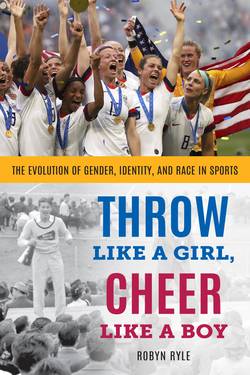Читать книгу Throw Like a Girl, Cheer Like a Boy - Robyn Ryle - Страница 16
На сайте Литреса книга снята с продажи.
Sports and the Stalled Revolution
ОглавлениеIn the 40 or so years since the beginning of the women’s movement in the United States and the passage of landmark legislation like Title IX, women have made impressive progress in revolutionizing the way we experience gender. But many men have not followed along. Researchers refer to this as the stalled revolution. More women are working than in the past. More women are achieving academic success. More women are occupying positions of power in society. Many more women are playing sports. What it means to be a woman has changed, but what it means to be a man isn’t particularly different for many men.
As a group, men haven’t caught up. Although the female partner in heterosexual couples may be working longer hours, the male partner has not significantly stepped up his contributions to housework and child care. With all of women’s success in the workplace, men still earn more income across most jobs in the United States, and many men aren’t bothered by that reality. In fact, many men direct their anger and hostility toward women and the gains they have made.
It might take a lot of hard work to un-stall the gender revolution and bring men up to speed, but perhaps the integration of sports is a good first step. The fact that sports remains a largely gender-segregated area of our social life serves to reinforce our beliefs about the fundamental differences between women and men, as well as women’s “natural” inferiority. Research tells us that when women and men play sports together, it changes the way male athletes think about gender.
In the not-so-distant past, all cheerleaders were boys and being a cheerleader was a powerful and important thing. Then girls started cheering, and a lot of the power that came with being a cheerleader went away. Today, women and men sometimes cheer together and sometimes play together, and their experiences may be an important lesson for all of sports, as well as the wider world.
1.
Jaime Schultz, Qualifying Times: Points of Change in U.S. Women’s Sports (Urbana: University of Illinois Press, 2014), 170.
2.
Elizabeth Sherman, “Why Don’t More People Consider Cheerleading a Sport?” The Atlantic, May 2, 2017, https://www.theatlantic.com/entertainment/archive/2017/05/why-dont-more-people-consider-competitive-cheerleading-a-sport/524940/ (accessed February 5, 2019).
3.
Schultz, Qualifying Times, 170.
4.
Ibid., 171.
5.
Ibid., 173.
6.
Ibid.
7.
Ibid., 75.
8.
Ibid., 174–76.
9.
Sally Jenkins, “History of Women’s Basketball,” WNBA, July 3, 1997, https://www.wnba.com/news/history-of-womens-basketball/ (accessed February 5, 2019).
10.
Schultz, Qualifying Times, 76.
11.
Ibid., 79.
12.
Ibid., 81–82.
13.
Ibid., 84.
14.
Ibid., 173.
15.
Ibid., 173–74.
16.
Ibid., 84–85.
17.
“LPGA Teaching and Club Professionals: A History,” LGPA, n.d., http://www.lpga.com/tcp/historytcp (accessed February 5, 2019).
18.
Bill Francis, “League of Women Ballplayers,” National Baseball Hall of Fame, n.d., https://baseballhall.org/discover-more/stories/baseball-history/league-of-women-ballplayers (accessed February 5, 2019).
19.
“A History of Women in Formula One,” CNN Sports, August 21, 2018, https://www.cnn.com/2018/08/21/motorsport/gallery/women-in-formula-one-spt-intl/index.html (accessed February 5, 2019).
20.
“Danica Patrick and the Women of NASCAR,” ABCNews, n.d., https://abcnews.go.com/Business/photos/women-nascar-danica-patrick-indy-500-14343965/image-19000228 (accessed February 5, 2019).
21.
Sherry Mabron Gordon, Women Athletes (Berkeley Heights, NJ: Enslow Publishing, 2017), 48; Ed Zieralski, “Timeline: Horse Racing’s Women Jockeys,” San Diego Union-Tribune, June 8, 2013, https://www.sandiegouniontribune.com/sports/horse-racing/sdut-women-jockeys-horse-racing-2013jun08-htmlstory.html (accessed February 5, 2019).
22.
Karen Blumenthal, Let Me Play: The Story of Title IX, the Law That Changed the Future of Girls in America (New York: Athaneum Books, 2005), 41–44.
23.
“Woman Kicks Extra Points,” New York Times, October 20, 1997, https://www.nytimes.com/1997/10/20/sports/woman-kicks-extra-points.html (accessed February 13, 2019).
24.
Jake Simpson, “How Title IX Sneakily Revolutionized Women’s Sports,” The Atlantic, June 21, 2012, https://www.theatlantic.com/entertainment/archive/2012/06/how-title-ix-sneakily-revolutionized-womens-sports/258708/ (accessed February 13, 2019).
25.
Blumenthal, Let Me Play, 38; Kristina Chan, “The Mother of Title IX: Patsy Mink,” The She Network, April 24, 2012, https://www.womenssportsfoundation.org/education/mother-title-ix-patsy-mink/ (accessed February 13, 2019).
26.
Simpson, “How Title IX Sneakily Revolutionized Women’s Sports.”
27.
Barbara Winslow, “The Impact of Title IX,” History Now: The Journal of the Gilder Lehrman Institute of American History, September 24, 2016, https://faculty.uml.edu/sgallagher/The_Impact_of_Title_IX-_GilderLehrman.pdf (accessed February 13, 2019); Jaeah Lee and Maya Dusenbery, “Charts: The State of Women’s Athletics, 40 Years after Title IX,” Mother Jones, June 22, 2012, https://www.motherjones.com/politics/2012/06/charts-womens-athletics-title-nine-ncaa/ (accessed February 13, 2019).
28.
Winslow, “The Impact of Title IX.”
29.
Lee and Dusenbery, “Charts.”
30.
Alana Semuels, “Poor Girls Are Leaving Their Brothers Behind,” The Atlantic, November 27, 2017, https://www.theatlantic.com/business/archive/2017/11/gender-education-gap/546677/ (accessed February 13, 2019).
31.
Schultz, Qualifying Times, 131–33; Blumenthal, Let Me Play, 65–74.
32.
Blumenthal, Let Me Play, 41–46.
33.
Dominque Debucquoy-Dodley, “NJ Youth Basketball Team Forfeits, Won’t Play Season without Girl Teammates,” CNN, February 16, 2017, https://www.cnn.com/2017/02/13/us/kid-basketball-season-trnd/index.html (accessed February 13, 2019).
34.
Debucquoy-Dodley, “NJ Youth Basketball Team Forfeits.”
35.
Eric Anderson, “‘I Used to Think Women Were Weak’: Orthodox Masculinity, Gender Segregation, and Sport,” Sociological Forum 23, no. 2 (2008): 260.
36.
Anderson, “‘I Used to Think Women Were Weak,’” 271.
